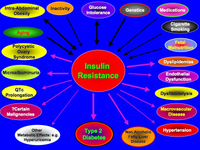Avandia and Heart Attacks: Hold Your Horses
The report in today’s New England Journal of Medicine about an apparent association between Avandia (rosiglitazone) and heart attacks made the front page of USA Today.
While it is an important study, it is important that we don’t go overboard until we have a little more information.
There is a key principle that we have looked at before: one study is rarely enough to prove that a thing is so. The scientific method is based on the principle of falsifiability: now that this data has been published it is up to scientists and investigators to try and disprove the finding.
The analysis in the New England Journal suggests that the risk of a heart attack increases by 43% for patients taking rosiglitazone compared to control groups, and the risk of death by heart attack by 64%. This data comes from the so-called “A Diabetes Outcome Prevention Trial” (ADOPT). This is one of three studies on the topic. The Diabetes Reduction Assessment with Ramipiril and Rosiglitazone Medication (DREAM) study that involved over 5,000 patients was published in the Lancet last September. This study showed small increases in cardiovascular events compared to controls, which were not statistically significant. The other key finding of the DREAM study was that it reduced the risk of progression of pre-diabetes to type 2 diabetes by 62%. That is important because it may mean that we need much longer studies: diabetes increases the risk of heart disease year after year. ADOPT involved more than 4000 patients, with the only significant relevant finding an excess of congestive heart failure episodes for rosiglitazone-treated patients compared with people who received the older diabetic medicine, glyburide (22 compared with nine events).
So there may be a signal there, but before stopping the medicine, we need to remember that the numbers of patients who developed problems is small. Obviously big enough if you are one of them, but the risk is still not that high given the high rates of heart diseases in people with diabetes.
There is another study on the horizon: The Rosiglitazone Evaluated for Cardiac Outcomes and Regulation of Glycemia in Diabetes (RECORD) trial, which is a phase III trial specifically designed to analyze cardiovascular events connected to use of rosiglitazone. The study that hit the front page is a meta-analysis, and even the authors admitted that there were some weaknesses in it. Though it is a personal choice that people have to make with their clinicians, many experts think that we can wait for the results of the third study so that we can make some sensible decisions.
And for the record, I have no connections with the manufacturer of Avandia, GlaxoSmithKline.
Half the Population Has Genes to Make Them Fat

I have talked a bit about my skepticism concerning the genetic contribution to obesity, insulin resistance and diabetes.
I was fascinated to see a huge fifteen year study that has just been published in the journal Science. I felt a touch of pride: back when the earth was new, I helped train more than one of the authors.
The study involved over 42,000 people and found an association with body mass index at every age [from seven to 70] in populations throughout the UK and Europe.
Unlike previous work, it shows a very common genetic link with mild obesity rather than a rare genetic link with extreme obesity.
There were 42 scientists in the group and they found that if people carry one copy of a variant in a gene called FTO, as does half of the general population, it will lead to a gain in weight of 2.6lb or put just over half an inch on their waists and raise their risk of being obese by one third. People with two copies of this variant in the FTO gene, which is the case in one in six of the population, then they will gain almost 7lb more than those who lack the variation and are at a 70 per cent higher risk of obesity.
The researchers then tested a further 37,000 people from Bristol, Dundee and Exeter as well as a number of other regions in Britain, Italy and Finland. In every case the same variant in the FTO gene – which is mostly present in the brain and pancreas, among other key tissues – was associated with type 2 diabetes and obesity.
They also showed that in children, this particular FTO variant was associated with increased body weight.
We hope that in the future, once we have found additional obesity genes, it may be possible to offer advice based on a person’s genetic make-up. We all know that folk are eating more and doing less exercise, but some people gain more weight than others. Similarly two people on the same diet and exercise plan lose different amounts of weight. There are undoubtedly some unrecognized factors in weight gain, but genes remain in the mix.
Never be disheartened if your first attempt at diet and exercise is not crowned with success: they are only two of a dozen factors that play into weight control.
Do not fall into the fatalistic trap of thinking that biology is destiny.
We are talking about a factor that may modulate the way in which we control out weight.
As promised, I shall soon be publishing a book detailing specific methods for dealing with whichever ones are important in your life.
Your future lies in your hands: not in a string of chemicals.
Linking Depression, Diabetes and Alzheimer’s Disease

It has been known for many years that Alzheimer’s disease and depression are associated with type 2 diabetes. Good control of blood glucose may reduce the risk of developing Alzheimer’s disease and depression, while treating depression may improve metabolic control.
Decreased levels of brain-derived neurotrophic factor (BDNF) have also been implicated in the pathogenesis of Alzheimer’s disease and depression, and animal models have suggested that BDNF may play a role in insulin resistance.
So a group of scientists at The Centre of Inflammation and Metabolism, Department of Infectious Diseases at the University of Copenhagen in Denmark, decided to see whether BDNF plays a role in human glucose metabolism.
In the first study they looked at 233 people and found that BDNF was inversely associated with fasting plasma glucose, but not with insulin. In a second smaller study they did what are known as hyperglycemic and a hyperinsulinemic-euglycemic clamp studies, that allowed them to look at the relationships between BDNF, glucose and insulin. What they found was that output of BDNF from the brain was inhibited when blood glucose levels were elevated.
So it seems that low levels of BDNF accompany impaired glucose metabolism. Decreased BDNF may be a factor involved not only in dementia and depression, but also in type 2 diabetes, and it may be the missing link that explains the way in which the three conditions cluster together in epidemiological studies
This link between a chemical produced in the brain and diabetes is not altogether unexpected. The French physiologist Claude Bernard demonstrated that stimulation of the fourth ventricle of the brain caused glucose to rise, and it was later found that opiates put into this region of the brain could do the same thing.
This study reinforced the close links between metabolism and the brain, and gives us another reason for recommending that as we get older we must ensure that out glucose remains stable and that we do not become depressed.
The Causes and Consequences of Insulin Resistance
I have spent so much time talking about insulin resistance becuase it is one of the greatest medical threats facing the world.
It is estimated that approximately 33% of the adult population of the United States is insulin resistant, and if left untreated many will develop diabetes, hypertension and an array of other problems. It is an epidemic that is expected to swamp most health care systems around the world, yet sadly it may in most cases be preventable.
There is an enormous literature on insulin resistance. As of this afternoon there are almost 33,000 scientific papers on the subject.
I created this graphic to try and summarize the key points about insulin resistance: the main factors that may cause it, as well as the most important medical consequences.

(Click on the graphic to expand it.)
The Main Causes of Insulin Resistance are:
- Aging
- Intra-abdominal obesity
- Inactivity
- Glucose intolerance
- Genetics
- Fetal malnutrition
- Cigarette smoking
- Some medications
The Main Consequences of Insulin Resistance are:
- Type 2 diabetes mellitus
- Hypertension
- Arteriosclerosis
- Polycystic ovarian syndrome
- Non alcoholic fatty liver disease
- Disturbances in the function of the vascular endothelium
- Elevations of triglycerides and cholesterol
- Disturbances of clotting
- Disturnaces in kidney function
- DIsturbances in one type of heart rhythm
- Elevated uric acide levels
- Some malignancies
This is probably not a complete list, but it gives you a very good idea of the reasons for looking for insulin resistance. Many – but not all – experts now recommend measuring insulin resistance in people at high risk of developing any of these medical problems.
We have good evidence that lifestyle changes can prevent the development of many of these dire consequences, so it is certainly something worth discussing with your health care provider.
Race and Diabetes

It’s another one of those, “Everyone knows that…” facts. For forty years we have all been taught that some ethnic groups are at higher risk of developing insulin resistance and type 2 diabetes mellitus. So now “everyone knows that” African Americans, Native Americans and people from the Indian sub-continent are all genetically predisposed to these medical maladies.
Now it looks as if “everyone” might have been wrong.
James Neel first proposed the theory of the “thrifty genotype” in 1962. He suggested that cycles of feast and famine early in human history created a gene that helps the body use scarce nutrients – a gene that leads to obesity and diabetes in sedentary modern populations with ready and continuous access to food.
Several months ago I pointed out some of the problems with the thrifty genotype theory, and why many of us have become more convinced about the concept of the “thrifty phenotype.” I have many friends, colleagues and former trainees who have dedicated themselves to hunting for diabetes genes. As early as the mid-1980s I was worried that they were going to vanish down a rabbit hole.
It seemed illogical that a gene or genes could “explain” an illness that was, until recently, very rare. It would have to be a gene that was somehow switched on and off by diet or some other environmental factors. It is certainly possible but seemed implausible, given that there are dozens of genes designed to control food intake and metabolism. But my friends the gene jockeys had the louder voice, and it was good for them to see what they could find. Now, twenty years later, more than 250 genes have been studied as possible causes of type 2 diabetes, but together these genes explain less than 1 percent of diabetes prevalence worldwide.
There is an interesting piece of research published in the journal Perspectives in Biology and Medicine by a team of researchers from the United States and Australia, that supports what I was saying. The study was co-authored by UC Irvine anthropologist Michael Montoya, an anthropologist at the University of California at Irvine, together with an epidemiologist and population geneticist. Together they analyzed existing genetic studies published across a variety of disciplines. The team found no evidence to support the thrifty genotype theory.
They also found that in most existing studies of the suspected genes that contribute to diabetes in ethnic minorities, researchers had failed to control for the potential impact of social and environmental factors. If those factors are taken into account, other factors – such as poverty, housing segregation or poor diet – were stronger indicators of diabetes than genes.
As Montoya said,
“Our study challenges the presumption that Native American, Mexican American, African American, Australian Aborigine, or other indigenous groups are genetically prone to diabetes because the evidence demonstrates that higher rates of diabetes across population groups can be explained by non-genetic factors alone. Our study shows that by focusing on genes, researchers miss the more significant and alterable environmental causes of diabetes.”
One of Montoya’s co-authors, Stephanie Malia Fullerton, a population geneticist and bioethicist at the University of Washington added,
“When it comes to diabetes, we’re finding that genes are no more important for ethnic minorities than for anyone else.”
This new critique of genetic and ethnic studies will need to be replicated, and it is a little bit of a surprise that such important work was published in Perspectives rather than one of the journals dedicated to epidemiology.
I have no inside knowledge about why the study was published where it was. But it often happens that it can be very difficult to get new research published if it contradicts the mainstream. There have been examples of experts squashing data that contradicts their own, but it is uncommon. Most of the time the difficulty in getting revolutionary new data published is not because of some conspiracy, but because any kind of evidence, particularly if it is radically different, attracts the most concentrated scrutiny by independent reviewers.
If this new data analysis is confirmed, it is going to mean a radical re-think about the ways in which we screen, manage and advise people from different ethnic groups.
It also confirms something that I’ve said a hundred times: Biology is Not Destiny.
Pesticides, Weight Gain and Insulin Resistance
On this blog and in Healing, Meaning and Purpose, I have talked about some of the less well recognized contributors to obesity, including:
- Stress
- Salt
- Viruses
- Pesticides
- Intestinal bacteria
There is some new evidence from Korea published in the journal Diabetes Care, supporting the possible contribution of pesticides to insulin resistance.
People with high levels of persistent organic pollutants (POPs) in their blood were more likely to develop insulin resistance, which may lead to type 2 diabetes. Insulin resistance may also lead to obesity, hypertension and an array of other diseases. It is well recognized that increasing amounts of intra-abdominal fat may increase insulin resistance. It is less well known that this obesity is part of a viscous circle, with insulin resistance being associated with elevated insulin levels that may cause fat to be laid down throughout the body. Once the fat is laid down in the abdomen, it can break down, releasing fatty acids and triglycerides that in turn affect the breakdown of insulin by the liver and the release of insulin by the pancreas.
Previous research by the same group found a link between POPs and type 2 diabetes. This study confirms that background exposure to some POPs, chemicals such as organochlorine pesticides and polychlorinated biphenyls (PCBs), is also associated with insulin resistance among people who do not yet have diabetes.
The researchers also found that the association between organochlorine pesticides and insulin resistance became stronger as people got fatter. However, among people who had very low concentrations of pesticides in their blood, the researchers found little association between waist size and insulin resistance.
Some studies have suggested an association between background exposure to POPs and a variety of adverse health effects in humans and wildlife. POPs can be particularly problematic because they persist for long periods of time in the environment, accumulate up the food chain, and can travel great distances through the air and water. Therefore, even people and animals that live nowhere near a place where POPs are being applied often show high levels of these chemicals in their bloodstream.
An international treaty banning a dozen of the world’s most dangerous POPs has helped reduce exposures, but many harmful chemicals remain in use and even those that have been banned may linger in our environment for years to come. For example, chlordane was banned two decades ago in the United States but continues to be present at high levels in our food supply.
The researchers concluded that some POPs "may be involved in the pathogenesis of insulin resistance." They advise urgent prospective studies among those who have background exposure to POPs, which mostly comes from eating fatty animal foods. Since obesity may increase the toxicity of POPs, controlling weight could also help to reduce the impacts of these molecules.
In separate research involving mice, Frederick vom Saal from the University of Missouri in Columbia, Missouri has studied the effects of a different class of endocrine-disrupting chemicals, including bisphenol-A (BPA). Not long ago, BPA made news in San Francisco, where there was a lot of controversy over an ordinance that seeks to ban its use in children’s products. vom Saal’s most recent work was presented at the 2007 Annual Meeting of the American Association for the Advancement of Science (AAAS). He found that endocrine-disrupting chemicals cause mice to be
born at very low birth weights and then very rapidly gain abnormally
large amounts of weight: they could more than double their body weight
in just seven days. Vom Saal followed the mice as they got older and
found that these mice were obese throughout their lives. He said
studies of low-birth-weight children have shown a similar
overcompensation after birth resulting in lifelong obesity.
(Regular readers might remember the concept of the thrifty phenotype, and see how this research ties in with that concept). More research must be done to determine which chemicals cause this metabolic effect. According to vom Saal, there are approximately 55,000 manmade chemicals in the world, and 1,000 of those might fall into the category of endocrine disrupting. These chemicals are found in common products, from plastic bottles and containers to pesticides and electronics.
These chemicals are so pervasive that it is difficult to avoid them, and there is scant evidence that "detoxification" helps clear them. That being said, and depsite the lack of evidence, we recommend certified organic produce and regular mild detoxification programs, together with nutritional support and tapping therapies.









